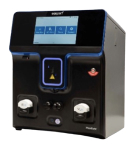QCA Adoption
MAXCYTE INC. (the "Company")
Introduction from the Chairman of MaxCyte, Inc.
The directors of MaxCyte (the “Directors” or “Board”) recognize the importance of good corporate governance and, as an AIM-listed Company, MaxCyte, Inc.(“MaxCyte” or the “Company”) adopts the Quoted Companies Alliance Corporate Governance Code (the “QCA Code”). The underlying principle of the QCA Code is that the purpose of good corporate governance is to ensure that the Company is managed in an efficient, effective and entrepreneurial manner for the benefit of all shareholders over the longer term. The table below sets out how the Company complies with the QCA Code. Further information on our compliance with the QCA Code is included in the Annual Report and Financial Statements for the year ended 31 December 2022.
Richard Douglas, PhD, Non-Executive Chairman
This page was last updated on 4 April 2023.
| No. | Application (as set out by the QCA) | Details of Compliance |
| Principle 1: Establish a strategy and business model which promote long-term value for shareholders |
|
1. |
The board must be able to express a shared view of the company’s purpose, business model and strategy. It should go beyond the simple description of products and corporate structures and set out how the company intends to deliver shareholder value in the medium to long-term. It should demonstrate that the delivery of long-term growth is underpinned by a clear set of values aimed at protecting the company from unnecessary risk and securing its long-term future. |
MaxCyte is a leading cell-engineering company focused on providing enabling platform technologies to advance innovative cell-based research as well as next-generation cell therapeutic discovery, development and commercialization. MaxCyte’s patented, high-performance, and scalable non-viral delivery platform (the ExPERT™) is used by hundreds of academic and bio-pharmaceutical customers globally to transfect, or deliver foreign molecules into cells, for a wide variety of applications – from protein production (including small molecule therapeutics, viral vectors, and vaccines) to the research, discovery, development, and manufacturing of next-generation, cell-based therapeutics in a fully GMP environment. MaxCyte licenses its ExPERTTM platform to researchers and bio-pharmaceutical customers for research, clinical and commercial use. MaxCyte also sells its Flow |
| Principle 2: Seek to understand and meet shareholder needs and expectations |
|
2. |
Directors must develop a good understanding of the needs and expectations of all elements of the company’s shareholder base. The board must manage shareholders’ expectations and should seek to understand the motivations behind shareholder voting decisions. | The Board attaches high importance to maintaining good relationships with all shareholders. The Executive Directors hold regular meetings with institutional shareholders to keep them updated on the Company’s performance, strategy, management and Board membership. The Executive Directors give regular briefings to analysts who cover the industry and actively encourage more analysts to follow the Company. Further, the Company holds an Annual General Meeting for all shareholders to attend and encourages open discussion and dialogue to understand shareholders’ needs and expectations. Beyond the Annual General Meeting, the Chief Executive Officer meets regularly with investors to provide them with updates on the Company’s business. The Company has a dedicated investor relations team which can be contacted at IR@maxcyte.com. |
| Principle 3: Take into account wider stakeholder and social responsibilities and their implications for long-term success |
|
3. |
Long-term success relies upon good relations with a range of different stakeholder groups both internal (workforce) and external (suppliers, customers, regulators and others). The board needs to identify the company’s stakeholders and understand their needs, interests and expectations. Where matters that relate to the company’s impact on society, the communities within which it operates or the environment have the potential to affect the company’s ability to deliver shareholder value over the medium to long term, then those matters must be integrated into the company’s strategy and business model. Feedback is an essential part of all control mechanisms. Systems need to be in place to solicit, consider and act on feedback from all stakeholder groups. | The Company is committed to sustaining progress and competitiveness in all aspects of its business. The Company is also aware of its corporate social responsibilities and the need to maintain successful working relationships between its employees, partners, suppliers, regulatory authorities and patients including those involved in its clinical development trials. Further, the Company regularly encourages feedback from its partners and customers through regular visits from its scientific, sales and marketing teams. The Company has implemented employee feedback sessions and holds regular meetings to inform employees regarding the Company’s progress, goals and strategy and encourage and receive employee feedback regarding all aspects of the Company's operations and working arrangements, wherever appropriate. The Company also takes pride in its corporate social responsibility efforts and continues to build and implement a framework to extend its health commitment to patients and its employees, the community and the environment through various initiatives. Further details of the Company’s corporate social responsibility initiatives are set out on page 29 of the Annual Report and Financial Statements for year ended 31 December 2022. All stakeholders are encouraged to provide feedback to the Company by emailing IR@maxcyte.com |
| Principle 4: Embed effective risk management, considering both opportunities and threats, throughout the organisation |
|
4. |
The board needs to ensure that the company’s risk management framework identifies and addresses all relevant risks in order to execute and deliver strategy; companies need to consider their extended business, including the company’s supply chain, from key suppliers to end-customer. Setting strategy includes determining the extent of exposure to the identified risks that the company is able to bear and willing to take (risk tolerance and risk appetite). | The Board has established Audit and Compensation Committees, full details of which are contained in the Corporate Governance section of the Company’s website. The risks faced by the Company are set out in the section titled “Risk Factors” in MaxCyte’s Registration Statement on Form S-1 and other filings with the U.S. Securities and Exchange Commission (the “SEC”). The Company’s SEC filings are also available on the Company’s website here and on the SEC’s website at www.sec.gov. The Management and the Board regularly monitor the Company's exposure to key business risks, with the input and assistance of the Audit Committee and its external auditors, and the progress of the Company towards the achievement of its strategic goals, budgets and forecasts. |
| Principle 5: Maintain the board as a well-functioning, balanced team led by the chair |
|
5. |
The board members have a collective responsibility and legal obligation to promote the interests of the company and are collectively responsible for defining corporate governance arrangements. Ultimate responsibility for the quality of, and approach to, corporate governance lies with the chair of the board. The board (and any committees) should be provided with high quality information in a timely manner to facilitate proper assessment of the matters requiring a decision or insight. The board should have an appropriate balance between executive and non-executive directors and should have at least two independent non- executive directors. Independence is a board judgment. The board should be supported by committees (e.g., audit, compensation, nomination) that have the necessary skills and knowledge to discharge their duties and responsibilities effectively. Directors must commit the time necessary to fulfill their roles. | The Board comprises eight Non-Executive Directors (including the Chairman) and one Executive Director. All the Non-Executive Directors are considered to be independent. All Directors receive regular and timely information about the Company’s operational and financial performance. The Board members are collectively responsible for defining corporate governance arrangements to achieve this purpose, under clear leadership by the Chairman. Formal Board meetings are scheduled at the start of each financial year. A formal agenda and the accompanying board papers are circulated in advance of each meeting. The Board has an Audit Committee, Compensation Committee and Nominating and Corporate Governance Committee. Further details of the Company’s committees including their composition can be found here and here as well as in pages 9 to 14 of the Annual Report and Financial Statements for year ended 31 December 2022. The Board is divided into three classes with staggered three-year terms. At each annual meeting of shareholders, the successors to Directors whose terms then expire will be elected to serve from the time of election and qualification until the third annual meeting following election. All the Directors commit the time necessary to fulfill their roles at the Company. Further details of the attendance of each of the Directors at the Board meetings during the last financial year ended 31 December 2022 are set out on page 5 of the Annual Report and Financial Statements. |
| Principle 6: Ensure that between them the directors have the necessary up-to-date experience, skills and capabilities |
|
6. |
The board must have an appropriate balance of sector, financial and public markets skills and experience, as well as an appropriate balance of personal qualities and capabilities. The board should understand and challenge its own diversity, including gender balance, as part of its composition. The board should not be dominated by one person or a group of people. Strong personal bonds can be important but can also divide a board. As companies evolve, the mix of skills and experience required on the board will change, and board composition will need to evolve to reflect this change. | The Board believes that its eight Non-Executive Directors and one Executive Director have the appropriate balance of skills between them, covering the life sciences industry, finance and public company management, all of which are considered important in terms of the strategic delivery of value to shareholders and stakeholders over the medium to long term. The Nominating and Corporate Governance Committee reviews the structure, size and composition of the Board, recommends changes to the Board, and identifies individuals qualified to become members of the Board. Where new Board appointments are considered, the search for candidates is conducted, and appointments are made, on merit, against objective criteria and with due regard for the benefits of diversity on the Board. Details of the skills and experience of each of the Directors is set out on pages 9 to 14 of the Annual Report and Financial Statements for the year ended 31 December 2022 and on the Board of Directors page of our website – here. The Board receives training from the VP, Legal, as required, in light of any changes to the law or best corporate governance. In addition, each Director will have access to the Company Secretary and external advisers, including legal counsel and the Company’s Nominated Advisor (the “Nomad”), to discuss any issues in order to have a full understanding before taking any decisions. The Directors also will also receive briefings and updates from the Company Secretary, Nomad and legal counsel when necessary, with respect to continued compliance with the AIM Rules for Companies, the UK Market Abuse Regulations and SEC rules for a Nasdaq-listed company. The Non-Executive Chairman (assisted by the Company Secretary) is responsible for advising the Board on corporate governance matters and facilitating the flow of information to and from the Board.
|
| Principle 7: Evaluate board performance based on clear and relevant objectives, seeking continuous improvement |
|
7. |
The board should regularly review the effectiveness of its performance as a unit, as well as that of its committees and the individual directors. The board performance review may be carried out internally or, ideally, externally facilitated from time to time. The review should identify development or mentoring needs of individual directors or the wider senior management team. It is healthy for membership of the board to be periodically refreshed. Succession planning is a vital task for boards. No member of the board should become indispensable. | The Board ensures it has appropriate expertise to meets the needs of the Company as outlined in Principle 6 and the Board evaluates its performance on an on-going basis. The Board will regularly review the effectiveness of its performance as a unit, as well as that of its committees and the individual directors. The Board performance review may be carried out internally or, preferably, externally facilitated from time to time. The Compensation Committee determines and agrees with the Board the framework or broad policy for the compensation of the Chief Executive Officer, other Officers and Senior Management as it is designated to consider and to take into account all factors which it deems necessary. The Board is responsible for determining the compensation of or the awards of any stock options to the Non-Executive Directors. The Nominating and Corporate Governance Committee will give full consideration to succession planning for both Executive and Non-Executive directors and other Senior Management in the course of its work, taking into account the challenges and opportunities facing the Company and what skills and expertise are therefore needed on the Board in the future. |
| Principle 8: Promote a corporate culture that is based on ethical values and behaviours |
|
8. |
The board should embody and promote a corporate culture that is based on sound ethical values and behaviours and use it as an asset and a source of competitive advantage. The policy set by the board should be visible in the actions and decisions of the chief executive and the rest of the management team. Corporate values should guide the objectives and strategy of the company. The culture should be visible in every aspect of the business, including recruitment, nominations, training and engagement. The performance and reward system should endorse the desired ethical behaviours across all levels of the company. The corporate culture should be recognisable throughout the disclosures in the annual report, website and any other statements issued by the company. | Our corporate governance is based on the leadership of our Board for the entire Company, and we believe it is essential to our ability to deliver our strategy. The Executive Directors regularly monitor the Company’s cultural environment and seek to address any concerns that may arise. In addition, the Board has adopted corporate governance guidelines. The Board has also adopted a code of conduct and ethics policy (the “Code of Conduct”). The adoption of the Code of Conduct is designed to: (1) inform employees about the criminal offence of insider dealing; (2) promote honest and ethical conduct; (3) promote full, fair, accurate, timely and understandable disclosure in reports and other public communications made by MaxCyte; (4) promote compliance with applicable government laws, rules and regulations; and (5) promote fair dealing practices and deter wrongdoing. As the Company grows, we will regularly review the extent and appropriateness of the Company’s corporate governance practices and procedures. The Board oversees compliance with relevant legislation and regulations, including the UK Market Abuse Regulation.
|
| Principle 9: Maintain governance structures and processes that are fit for purpose and support good decision-making by the board |
|
9. |
The company should maintain governance structures and processes in line with its corporate culture and appropriate to its:
|
The role of the Chairman is to lead and oversee the Board, and to promote good corporate governance within the Company. The Chief Executive Officer has responsibility for the business operations, for implementing the Company's strategy and for the day to day running of the business. The Governance Report on pages 9 to 14 of the Annual Report and Financial Statements for year ended 31 December 2022 sets out further details of the Company’s governance structure and the roles and responsibilities of the Directors, the Board and its committees. |
| Principle 10: Communicate how the company is governed and is performing by maintaining a dialogue with shareholders and other relevant stakeholders |
|
10. |
A healthy dialogue should exist between the board and all of its stakeholders, including shareholders, to enable all interested parties to come to informed decisions about the company. In particular, appropriate communication and reporting structure should exist between the board and all constituent parts of its shareholder base. This will assist:
|
The Company values its communications with all its stakeholders. The Company’s website is updated on a regular basis and users have the ability to view the description of the Company’s business as well as its financial statements as they become available. As noted under Principal 2, the Executive Directors are in regular communication with shareholders to share information regarding the Company and to understand the views of shareholders, which are communicated to the Board by the Executive Directors as appropriate. The Company’s financial reports can be found here. Notices of General Meetings of the Company can be found here. The results of voting on all resolutions in future general meetings will be posted to the Company’s website, including any actions to be taken as a result of resolutions for which twenty (20) percent of independent shareholders have cast votes against. Shareholders and stakeholders with specific queries about MaxCyte may contact the Company directly at IR@maxcyte.com |





